mobile View, to the German Version tap the flag


- Republic of Ingushetia
- also: Ingushia
- federal component of the Russian Federation (Russia)
- own name: Ğalğaj Moxk
• Flag
• Historical Flags
• Meaning/Origin of the Flag
• Coat of Arms
• Map
• Numbers and Facts
• History
• Origin of the Country's Name
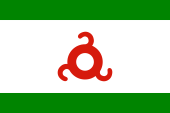
since 1999,
National flag,
ratio = 2:3,
Source, by: Russiatrek




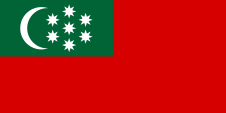
1920–1924,
Flag of the Autonomous Soviet Mountain Republic,
ratio = 1:2,
Source, by: Wikipedia (DE)



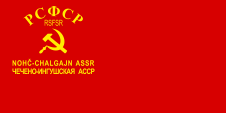
1937–1944,
Flag of the Chechen-Ingush Autonomous Soviet Socialist Republic,
ratio = 1:2,
Source, by: World Statesmen



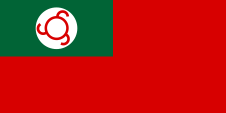
1942–1944,
Flag of the Checheno-Ingushetia,
ratio = 1:2,
Source, by: World Statesmen



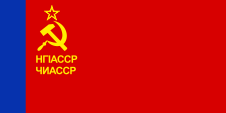
1958–1980,
Flag of the Chechen-Ingush Autonomous Soviet Socialist Republic,
ratio = 1:2,
Source, by: World Statesmen



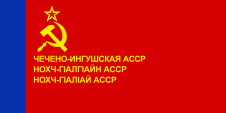
1980–1990,
Flag of the Chechen-Ingush Autonomous Soviet Socialist Republic,
ratio = 1:2,
Source, by: World Statesmen



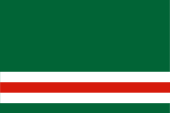
1990,
Flag of Checheno-Ingushetia,
ratio = 2:3,
Source, by: World Statesmen



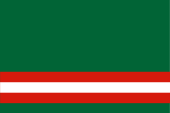
1990–1991,
Flag of Checheno-Ingushetia,
ratio = 2:3,
Source, by: World Statesmen



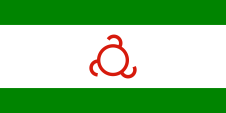
1994–1999,
National flag of Ingushetia,
ratio = 1:2,
Source, by: Wikipedia (FR)



look also:
Flag history of the soviet republics of the USSR

The today's flag of Ingushetia was introduced in 1994. It shows three strips in green, white and green in the ratio of 1:4:1 and in the middle a red triskelion. The triskelion embodies the sun and the universe, but it also stands for the awareness of the oneness of the spirit in the past, present and future. The colour red symbolizes the struggle for existence and the defending of the homeland, white symbolizes the god-given purity of the spirit and the morality of the people, green stands for Islam. To 1999 the flag was used in the side-ratio of 1:2. After that they went to the now in Russia usual ratio of 2:3. The shape of the triskelion changed slightly, and is until today reproduced quite differently. Chechnya was united with Ingushetia for many years. As the common Chechen Ingushetic Autonomous Soviet Republic, the country had some flags, following the always same Soviet knitting pattern. Only from 1942 to 1944 was an other flag in use, when the country broke with the Soviet Union in World War II and defected to the side of the German Empire. The flags, which were used in the Soviet era corresponded all to the same pattern as it was intended for the Soviet Autonomous Republics: Between 1923 and 1937 frequently only a single-coloured red bunting with a golden inscription, showing the name of the country. Sometimes only as a shortcut, sometimes the full name, sometimes only in Russian or even multilingual. From about 1937 hammer, sickle and star were sometimes added. From about the mid-50s multicolored flags were introduced for the republics of the Soviet Union, whose knitting patterns had to be taken over by the subordinated autonomous Soviet republics.
Source:
Wikipedia (FR),
World Statesmen,
Flaggen Enzyklopädie

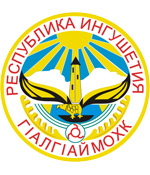
Coat of arms of Ingushetia,
Source: Russiatrek

geographical position within Russia:
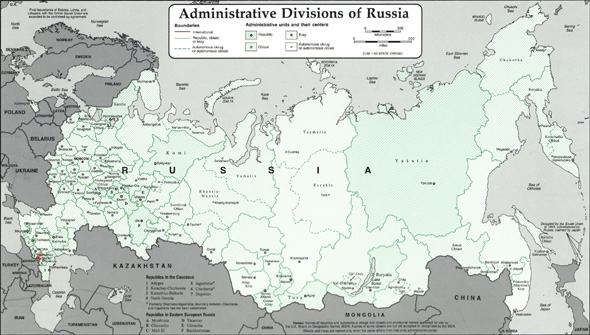
Source: Freeware, russiamap.org, modyfied by: Volker Preuß
enlarge – click here
Map of the country:

Source: By Don-kun [CC BY-SA 3.0 or GFDL], via Wikimedia Commons
enlarge – click here

Area: 1.400 square miles
Inhabitants: 488.043 (2018)
Density of Population: 348 inh./sq.mi.
Capital: Magas, 2.500 inh. (2010)
Capital to 2003: Nasran, 93.335 inh. (2010)
official Languages: Russian, Ingush
other Languages: Chechen
Currency: Russian currency
Time Zone (from 28th of March 2010): GMT + 3 h
Time Zone (to 28th of March 2010): GMT + 4 h
Source:
Wikipedia (D)

10th century · in the region establishes a state of the Alans, capital is Magas
13th century · conquest and destruction by the Mongols, the region comes to the Golden Horde, in the mountains the Alans kept their language and culture
16th–17th century · decline of the Golden Horde, the Alans return to the plains
1770 · conquest by Russia, incorporation
1810 · Treaty of Vladikavkaz, Ingushia becomes a protectorate and ally of Russia
1817–1864 · Caucasus War, the Ingush fight on Russia's side, but some of them also on the side of the Imamat Caucasus under Imam Shamil, these became mostly expelled into the Ottoman Empire, settlement of Russians
1917 · Bolshevist coup in Russia
1917–1918 · civil war in Russia
March 1918 · establishment of the Soviet dictatorship
1921–1924 · Ingushia is part of the Autonomous Soviet Mountain Republic (Mountain People's ASR) within the Soviet Union (USSR), which unites the Ingush with Carbadians, Chechens, Circassians, Ossetians, Balkars and Karachai
1924 · Ingushia becomes an autonomous district (Oblast) of the Russian Federation, the political and intellectual leaders of the country become deported
1934 · Ingushia is united with Chechnya to the Chechen-Ingush Autonomous Oblast
1936 · the Chechen-Ingush Autonomous Oblast is transformed into the Chechen-Ingush Autonomous Soviet Socialist Republic (CheIASSR)
1944 · the CheIASSR is dissolved, Chechens and Ingush become deported to Central Asia, large parts of the country are connected to neighboring Soviet republics
1953 · the Chechens and Ingush are allowed to return step by step to their homelands
January 1957 · reconstruction of CheIASSR
15th of May in 1991 · declaration of state sovereignty, renamed in Chechen-Ingush Republic
1st of October in 1991 · as a result of Chechen independence efforts, the Supreme Soviet of the RSFSR decides to divide the country into the Chechen Republic and the Ingush Republic
31st of December in 1991 · the Soviet Union dissolves, the constitution of the Russian Socialist Federative Soviet Republic (RSFSR, Russia), a former substate of the Soviet Union, remains in force for the time being
25th of December in 1993 · a new constitution for Russia (Russian Federation) comes into force, and the relationships with the members of the federation is re-regulated in this way
1992–1995 · fights with North Ossetia
2003 · Magas is declared the capital, hitherto Nazran
2004 · invasion of Chechen and Ingush separatists
2008 · heavy armed attacks by Islamists
2008 · the country's president is removed from office and replaced by an army general
2018 · Territorial exchange of disputed territories between Ingushetia and Chechnya
Source:
Atlas zur Geschichte,
World Statesmen,
Russiatrek,
Die Völker der Erde,
Wikipedia (DE)

The name of the country goes back to the here living nation of the Ingush, whose name was probably given to them by the Russians. The Ingush call themselves as "Galsai".
Source:
Wikipedia (RU)

Surftipp:
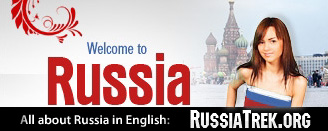

![]()
































